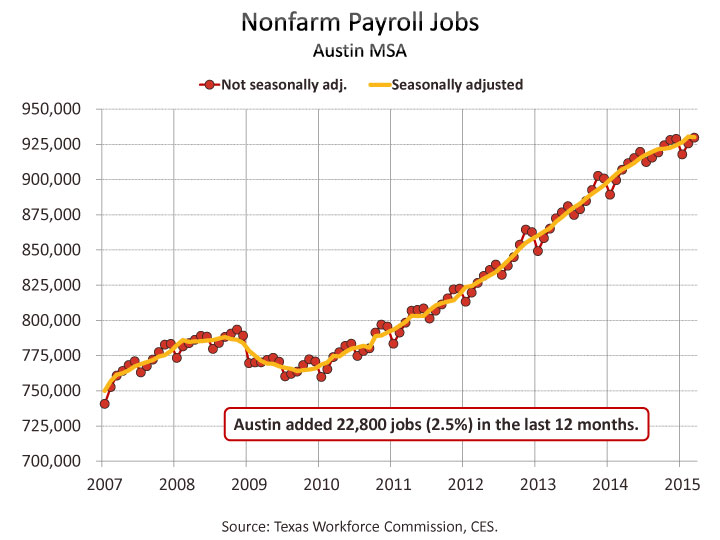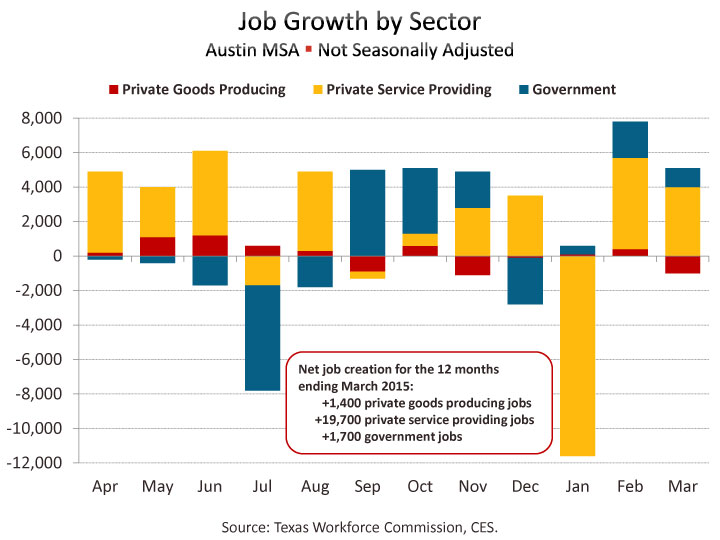Job Growth & Unemployment
Posted on 04/21/2015 by Beverly Kerr
The Austin metropolitan area added 22,800 jobs, or 2.5%, in the 12 months ending in March, according to the latest release of payroll jobs numbers by the Texas Workforce Commission (TWC) and the Bureau of Labor Statistics’ (BLS). Today’s BLS release of this data for all U.S. metros shows that Austin’s 2.5% growth makes it the 29th best performing among the 50 largest metro areas. Dallas grew by 4.0%, ranking 5th. The other major Texas metros missed the top 10, but each had greater growth than Austin. San Antonio grew by 3.4% (14th), Houston grew by 2.9% (22nd) and Fort Worth grew by 2.6% (28th) between March 2014 and March 2015.
This month's estimates show moderating growth compared to February, when each of the top 10 fastest growing metros had year-over-year growth in excess of 4.0%. In aggregate, jobs in the 50 largest metros grew by 2.5% over the last 12 months, compared to 2.7% for the 12 months ending in February.
Earlier this month, IHS Global Insight gave their semiannual economic outlook presentation to the Texas Comptroller's office. Their projection of the fastest growing large U.S. metros for 2015-2020 places Austin first, with an annual average growth rate of 2.6%.
For the year ending in March, private sector job growth in the Austin MSA was 2.9%, or 21,100 jobs, and with all private industry divisions, but one, contributing to the growth. Austin's large government sector (nearly 19% of jobs) saw modest growth over the last 12 months, gaining only 1,700 jobs or 1.0%, thus bringing the overall job growth rate to 2.5%.

Texas saw stronger net private sector job growth of 3.2% with all private industry divisions adding jobs over the last 12 months. As with Austin, total job growth statewide was lower, 2.8%, due to the only moderate growth (0.9%) in the government sector, which accounts for over 16% of total state employment. For the nation, private sector growth was 2.6% for the 12 months ending in March (national data is presently a month ahead of state and local data), with all private industries adding jobs. Overall job growth was a more modest 2.3% because the government sector gained only 0.3%.

Jobs in March are up from the preceding month by 3,000 jobs or 0.3% in the not-seasonally-adjusted series for Austin, however, February-to-March change on a seasonally adjusted basis is virtually unchanged (down 400 jobs or 0.0%). Statewide, seasonally adjusted jobs fell by 25,400 or 0.2%. On a seasonally adjusted basis, jobs also fell in March in Dallas (-0.3%), and Fort Worth (-0.2%), and San Antonio (-0.1%). Houston’s jobs were virtually unchanged (down 300 or 0.0%). Nationally, seasonally adjusted jobs rose 0.1% in March.

In Austin, the industry adding the most jobs and growing at the fastest rate was education and health services, which grew by 5,200 jobs or 5.0% over the last 12 months. Also growing at faster-than-average rates were information (4.9% or 1,200 jobs); wholesale trade (4.7% or 2,100 jobs); transportation, warehousing and utilities (3.9% or 600 jobs); other services (3.6% or 1,400 jobs); and leisure and hospitality (3,200 or 3.0%). Manufacturing employment was unchanged.

Statewide, construction and natural resources grew fastest over the last 12 months—adding 4.9% or 45,800 jobs. Education and health services added the most jobs—59,100 or 3.9%. Three other industries were also relatively fast growing: transportation, warehousing and utilities (up 4.5%); wholesale trade (4.2%); and leisure and hospitality (4.1%). Manufacturing saw the least growth (0.3%).
Nationally, professional and business services added the most jobs (659,000) and gained 3.5% over the 12 months ending in March. Construction and natural resources saw the largest percent change (4.2%). Transportation, warehousing and utilities and leisure and hospitality also grew at faster-than-average rates (3.3% and 3.4% respectively). No industry lost jobs.

The net gain for private service-providing industries in Austin is 19,700 jobs, or 3.1%, over the last 12 months and the net gain for goods producing industries is 1,400, or 1.3%. Statewide, private service-providing industries are up 256,300 or 3.3% and goods producing industries are up 48,000 or 2.7%.
We also now have March labor force, employment, and unemployment numbers for Texas and local areas in Texas. The same data for all U.S. metros that we often do a ranking of will not be released until April 29. In February, Austin had the lowest rate of unemployment among the 50 largest metros.

Unemployment numbers for March show Austin’s performance relative to the state and other major Texas metros being sustained. In March, Austin is at 3.3%, while the other major metros range from 3.7% in San Antonio to 4.2% in Houston. Dallas and Fort Worth are at 4.0% and 4.1%, respectively. Austin’s rate one year ago was 4.4%. The rates in Texas’ other major metros are 1.0 to 1.4 percentage points improved on the rates seen a year ago. Within the Austin MSA, Travis County has the lowest unemployment rate in March, at 3.2%, while Caldwell County has the highest at 4.1%. The rate is 3.3% in Hays County, 3.4% in Williamson County, and 3.7% in Bastrop County. The statewide not-seasonally-adjusted rate is now 4.2%, compared to 5.4% in March of last year. The March national rate is 5.6% compared to 6.8% in March of last year.

On a seasonally adjusted basis, Austin’s March unemployment rate is 3.4%, unchanged from February. The last time seasonally adjusted unemployment fell as low as 3.4% in Austin was March of 2001.
San Antonio has the next lowest seasonally adjusted rate at 3.7%, while Dallas, Fort Worth, and Houston are at 4.0%, 4.1% and 4.2%, respectively. March rates are unchanged from February in each metro except San Antonio which sees a 0.1 point improvement. The statewide rate is 4.2%, down from 4.3% in February. Nationally, the seasonally adjusted unemployment was 5.5% in both February and March. Seasonally adjusted unemployment rates for Texas metros are produced by the Federal Reserve Bank of Dallas. (The TWC also produces seasonally adjusted rates for Texas metros, but publication lags the Dallas Fed’s data.)

With Austin’s unemployment rate down from one year ago, the number unemployed has also declined. In March 2014, Austin’s number of unemployed was 46,258, and has decreased by 12,039 or 26.0%, to 34,219.
The Austin metro’s civilian labor force (employed plus unemployed) decreased by 1,680 or 0.2% in the last 12 months, while persons employed increased by 10,359 or 1.0%. Texas saw larger growth in employed (1.3%) than in labor force (0.1%), and 150,950 fewer people (21.4%) are unemployed. Nationally, March civilian labor force is up by 0.4%, while employed is above the level of a year ago by 1.8%, and 1.86 million fewer people (17.6%) are unemployed.

This is only the second time in 17 years that estimates show Austin’s labor force to have contracted on a year-over-year basis. The other instance was in 2002. While the state’s year-over-year change is not yet negative, both labor force and employment change follow a steep decline in growth over the last six months comparable to that seen in Austin’s data.
Labor force and employment and nonfarm payroll jobs are derived from two different surveys (of households for labor force and employment and of business establishments for payroll jobs) and do not always move in the same direction. However, Austin’s persistently moderating job growth over the last several months would seem to be tracking with a similar pattern in labor force and employment.

As we noted in our article about labor market data through February, the Dallas Fedhas pointed to a tightening labor market in Austin, and across the state, accounting for slowing growth in nonfarm payroll jobs. At the same time, they noted the underlying strength of the Austin economy and an expectation that Austin’s growth may again exceed that of the state during 2015.
Texas Workforce Commission will release April estimates on May 22.
The Chamber’s Economic Indicators page provides up-to-date historical spreadsheet versions of Austin, Texas and U.S. data for both the Current Employment Statistics (CES) and Local Area Unemployment Statistics (LAUS) data addressed above.
Related Categories: Central Texas Economy in Perspective
